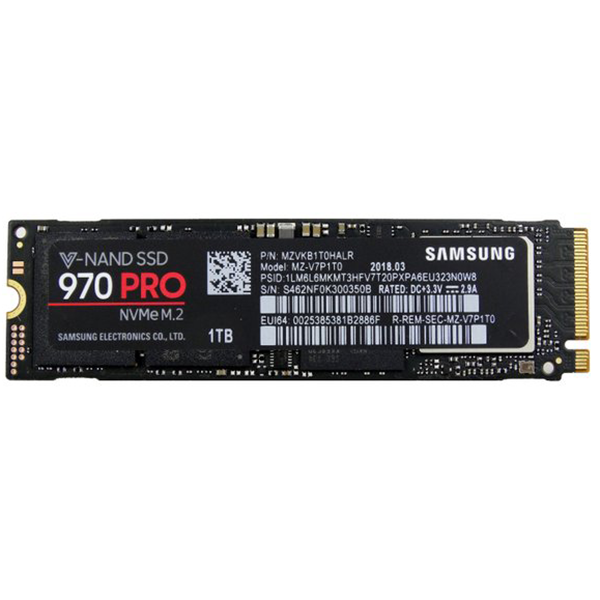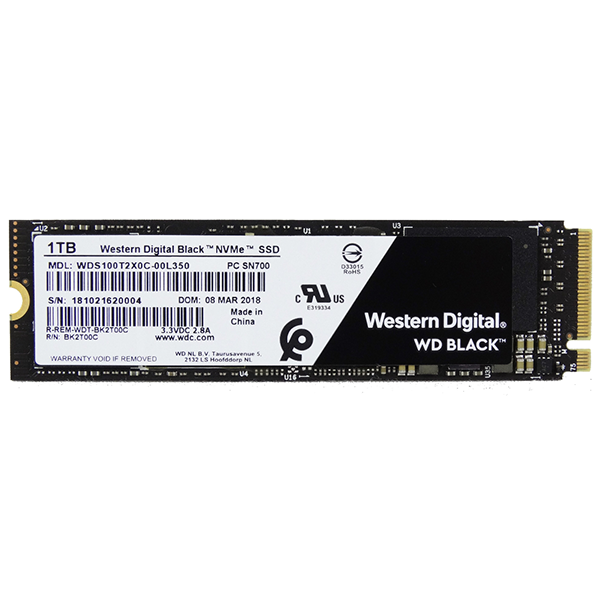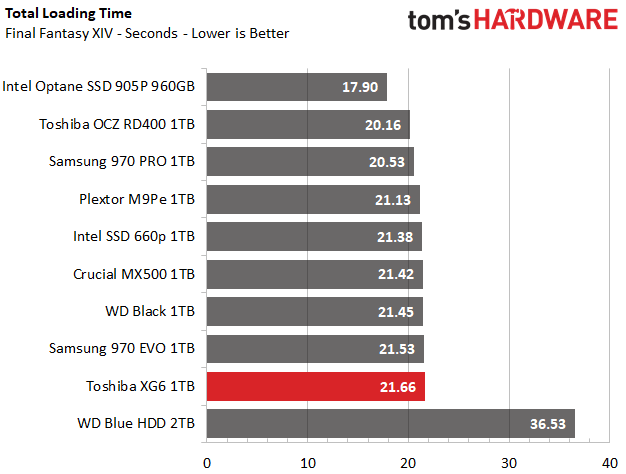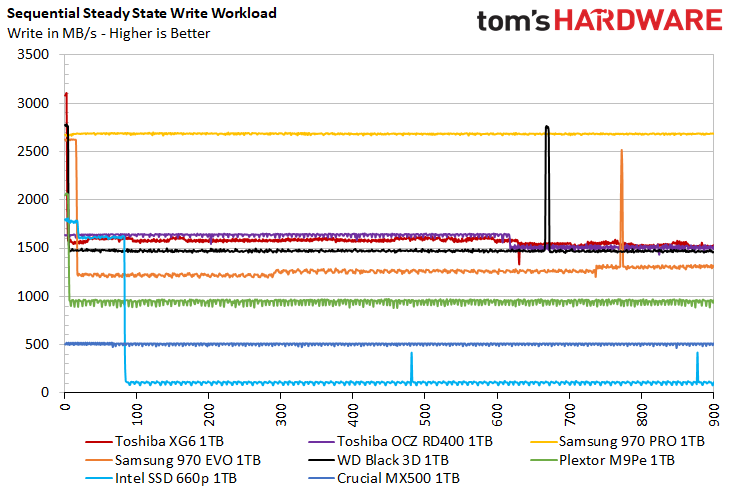Toshiba XG6 M.2 NVMe SSD Review: Higher Density and Improved Efficiency
Why you can trust Tom's Hardware
Performance Results
Comparison Products
We included the Samsung 970 EVO and Pro in our comparison pool. These high-performance (and popular) SSDs feature Samsung’s 64-Layer V-NAND in TLC and MLC flavors, respectively. We also threw in the WD Black, Plextor M9Pe, and the RD400. Finally, we included the Intel 660p and the Crucial MX500. The Intel 660p is a new NVMe SSD based on QLC NAND, but it comes at SATA pricing. The MX500 is one of the best SATA SSDs on the market.
Trace Testing – PCMark 8 Storage Test 2.0
PCMark 8 is a trace-based benchmark that uses Microsoft Office, Adobe Creative Suite, World of Warcraft, and Battlefield 3 to measure the performance of storage devices in real-world scenarios.
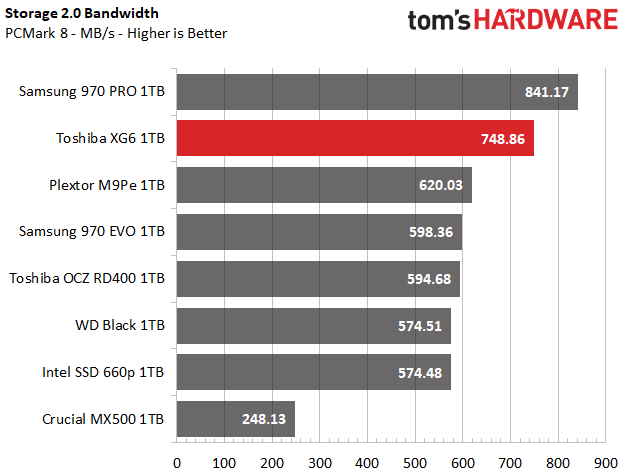
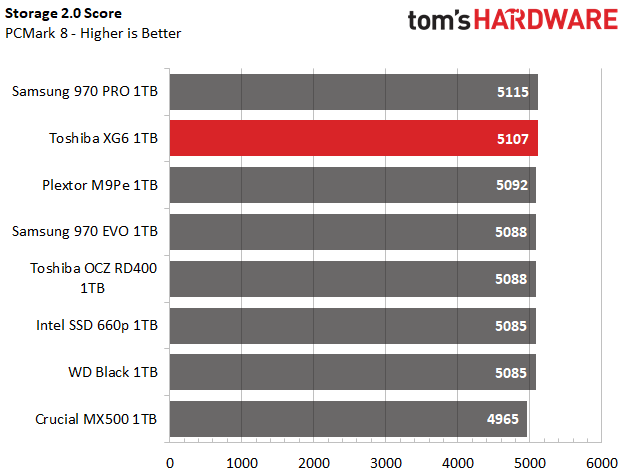
The Toshiba XG6 ranked second to the Samsung 970 Pro. That is quite an impressive feat considering the 970 Pro is an MLC-based performance-oriented product for professionals while Toshiba's XG6 is a mainstream TLC-based drive for mainstream consumers.
Game Scene Loading - Final Fantasy XIV
The Final Fantasy XIV StormBlood benchmark is a free real-world game benchmark that easily and accurately compares game load times without the inaccuracy of using a stopwatch.
In contrast to the incredible result we saw in PCMark 8, the XG6 fell into last place among the SSDs during the Final Fantasy game loading benchmark. Even the SATA-based Crucial MX500 provided better performance, albeit by the slimmest of margins. The XG6 outperformed the 2TB HDD by 15 seconds.
Transfer Rates – DiskBench
We use the DiskBench storage benchmarking tool to test file transfer performance with our own custom 50GB block of data. Our data set includes 31,227 files of various types, like pictures, PDFs, and videos. We copy the files to a new folder and then follow up with a read test of a newly-written 6 GB file.
Get Tom's Hardware's best news and in-depth reviews, straight to your inbox.
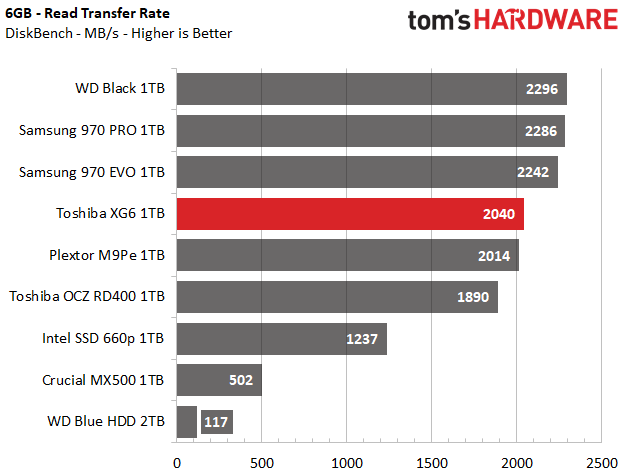

The Toshiba XG6 fared well during our 50GB mixed read/write file transfer workload. The drive averaged 339 MB/s, which ranked behind the Samsung 970 Series and WD Black but outperformed the RD400, 660p, and surprisingly, the Plextor M9Pe.
The rankings followed a similar pattern during the 6GB file read test. Due to the advantages of the PCIe bus and the efficient NVMe protocol, nearly all NVMe SSDs excel during read-centric workloads. We recorded a 4X improvement over the MX500 SATA SSD and nearly a 20X improvement over a standard 3.5” HDD.
SYSmark 2014 SE
Like PCMark, SYSmark uses real applications to measure system performance. SYSmark takes things much further, however. It utilizes fourteen different applications to run real workloads with real data sets to measure how overall system performance impacts the user experience. BAPCo's SYSmark 2014 SE installs a full suite of applications for its tests, which includes Microsoft Office, Google Chrome, Corel WinZip, several Adobe software applications, and GIMP. That also makes it a great test to measure the amount of time it takes to install widely-used programs after you install a fresh operating system.


We installed SYSmark 2014 SE to the XG6 in just under 15 minutes, tying the Plextor M9Pe for second place. The XG6 scored a relatively low (at least for an NVMe SSD) 1,645 responsiveness points. That trailed the other NVMe SSDs and barely came out ahead of the SATA-based MX500. The XG6 will provide end users with a snappy and responsive experience, but it appears it could benefit from more firmware tuning.
ATTO
ATTO is a simple and free application that SSD vendors commonly use to assign sequential performance specifications to their products. It also gives us insight into how the device handles different file sizes.
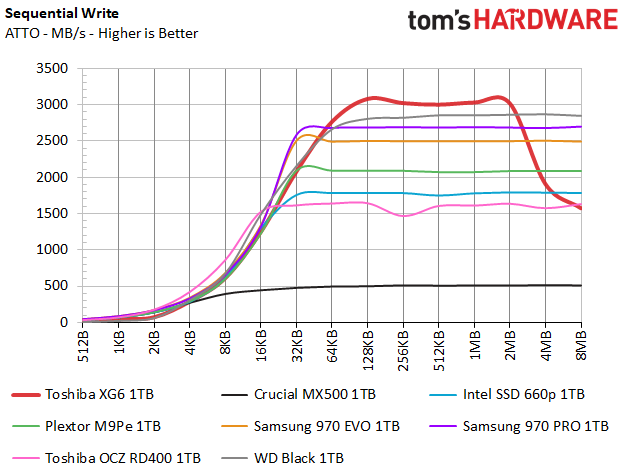
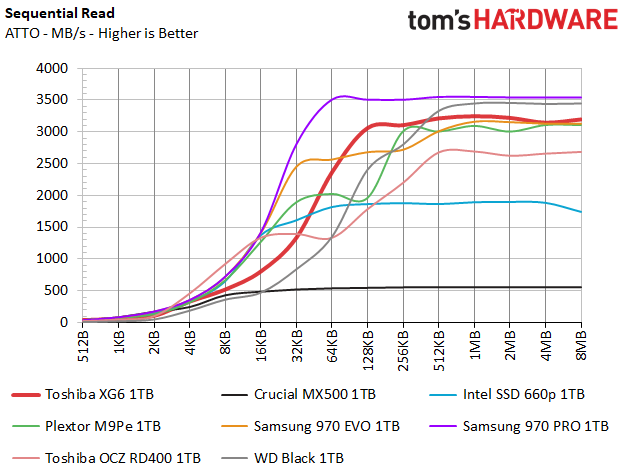
The Toshiba XG6 isn’t as optimized for smaller files as the other SSDs in our comparison pool, which might be a factor in its relatively low SYSmark score. The XG6 ramped up to 3.2 GB/s slowly as it worked through the small files in the read workload. The same pattern emerged with small files during the write test, but the difference between other SSDs wasn’t as large. The XG6 peaked at 3 GB/s during the write test but fell to 1.57 GB/s at the 8MB file size as the workload spilled from the SLC cache into the native TLC storage.
Anvil's Storage Utilities
Anvil's Storage Utility is a commonly-referenced benchmark that simplifies the complex IOMETER benchmark and its underlying Dynamo engine with a one-click software wrapper.
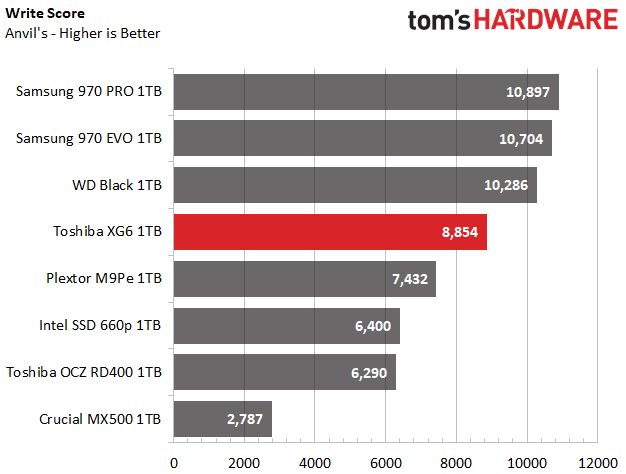
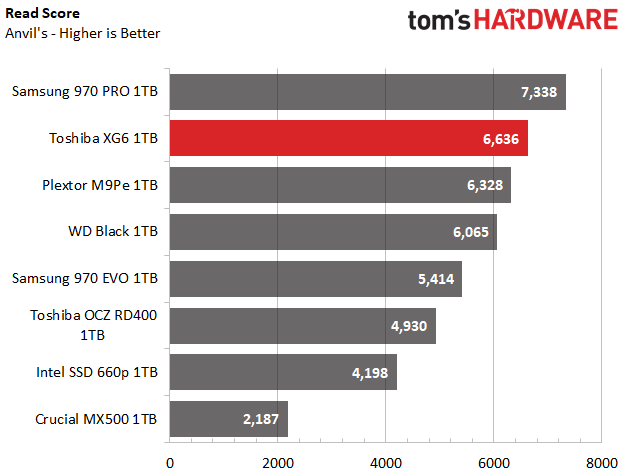
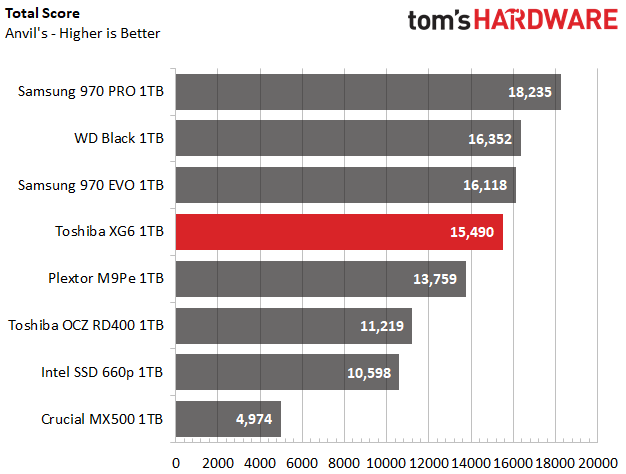
The Toshiba XG6 landed in fourth place overall behind the Samsung 970 EVO. In contrast to our observations in ATTO, the XG6 did well during the read portion of this test.
CrystalDiskMark
CrystalDiskMark (CDM) is a simple and easy to use file size benchmarking tool.

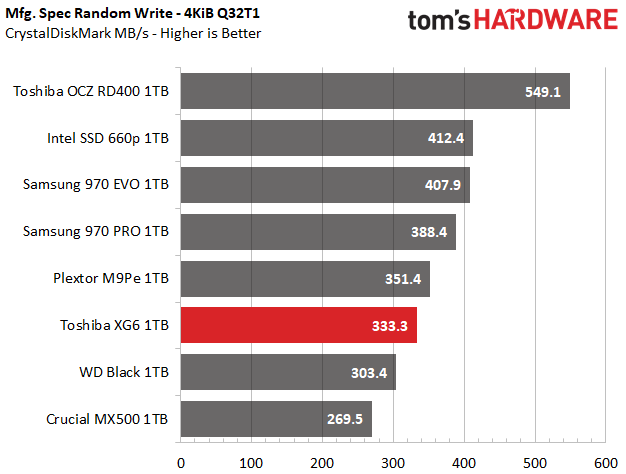
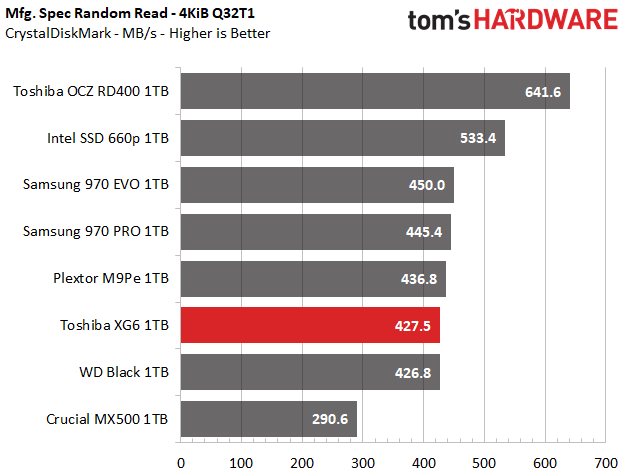

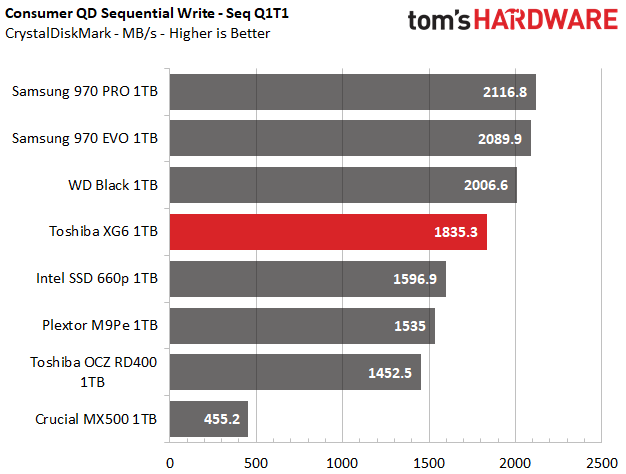



The Toshiba XG6 delivered the expected performance results of 3.25/2.97 GB/s of sequential read/write throughput at a Queue Depth (QD) of 32. The XG6 delivered 1.26/1.83 GB/s of sequential read/write throughput at QD1, which is more representative of performance in a normal workload.
Sustained Sequential Write Performance
Official write specifications are only part of the performance picture. Most SSD makers implement an SLC cache buffer, which is a fast area of SLC-programmed flash that absorbs incoming data. Sustained write speeds can suffer tremendously once the workload spills outside of the SLC cache and into the "native" TLC or QLC flash. We hammer the SSDs with sequential writes for 15 minutes to measure both the size of the SLC buffer and performance after the buffer is saturated.
The Toshiba XG6 has a rather small SLC cache relative to its total capacity. The SLC cache is roughly 10GB, so it fills in as little as 3-4 seconds. Once the buffer is full, performance drops to the lower speed of the TLC flash. The XG6 fills rather quickly, but its write speed stood tall at an impressive 1.5GB/s.
Power Consumption
We use the Quarch XLC Programmable Power Module to gain a deeper understanding of power characteristics. Idle power consumption is a very important aspect to consider, especially if you're looking for a new drive for your laptop. Some SSDs can consume watts of power at idle while better-suited ones sip just milliwatts. Average workload power consumption and max consumption are two other aspects, but performance-per-watt is more important. A drive might consume more power during any given workload, but accomplishing a task faster allows the drive to drop into an idle state faster, which ultimately saves power.
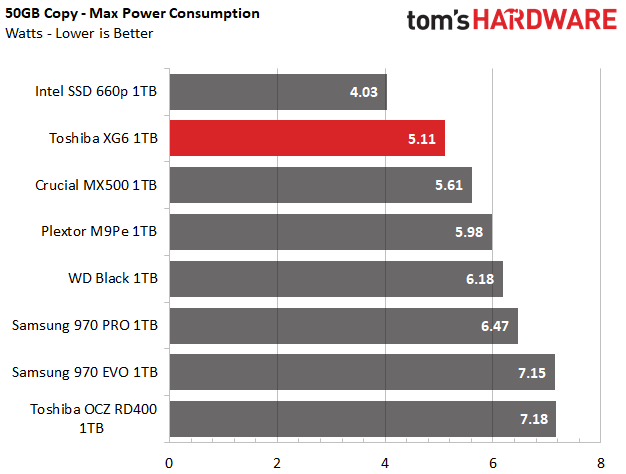

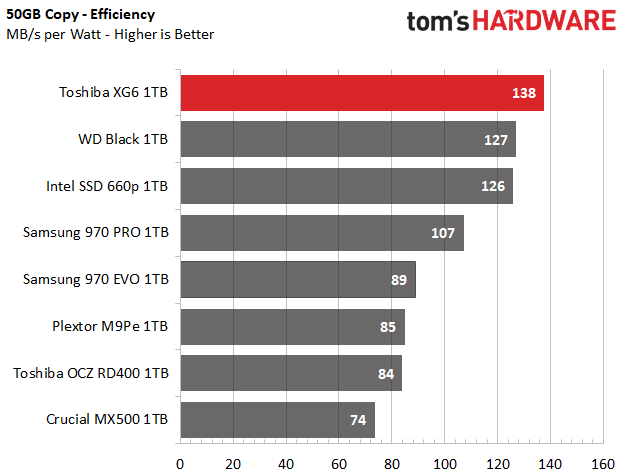

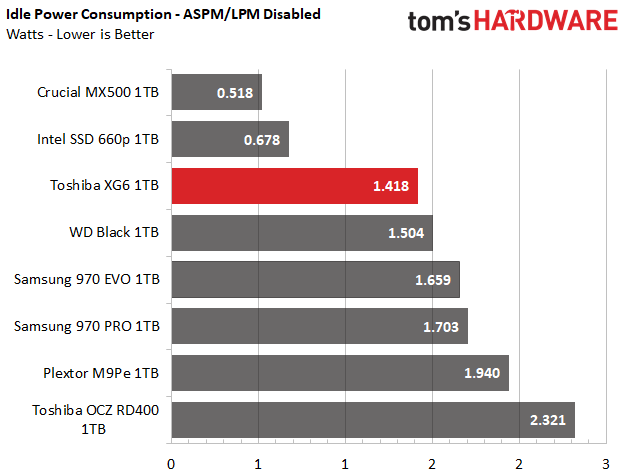
The Toshiba XG6's 138 MB/s of throughput-per-watt made it one of the most efficient SSDs we've tested. The XG6's 2.46W average and 5.11W maximum results were significantly less than the other TLC NVMe SSDs, and almost half that of the MLC-based Samsung 970 EVO under load.
The XG6’s idle power consumption was also impressive. The 1.4W average with ASPM disabled might seem high, but it was lower than the rest of the high-performance SSDs. SATA-based SSDs are usually more efficient when power savings features are disabled, so it wasn't surprising to see the MX500 win that test. The XG6's idle power consumption dropped to just 0.173W (173mW) when we enabled the power saving features.
MORE: Best SSDs
MORE: How We Test HDDs And SSDs
MORE: All SSD Content

Sean is a Contributing Editor at Tom’s Hardware US, covering storage hardware.
-
Brian_R170 Why bother to review this model if consumers can't even buy it except in a pre-built system? How many people make their system purchase decisions based on the SSD inside? Outside of boutique stuff, how many OEMs actually list the SSD model in their specifications?Reply
Plus, any future SSD design based off of this model won't likely have identical specs, so you'd have to retest it anyway. -
2Be_or_Not2Be Why is the Intel Optane 905P included on some benchmarks and not on others? It would be nice to have consistency throughout the review. Either have it in all of the benchmarks, or just don't include it at all.Reply
I understand you may be including results from a previous test on the 905P that may not have had all of the same tests as this XG6. However, it's frustrating to me when I see it one benchmark (I do like that it's included), but then when I want to compare against it on another one, it's not there.
So I would say if you don't have it for all of the tests, just exclude it from all of them. -
Paul Alcorn Reply21276173 said:Why is the Intel Optane 905P included on some benchmarks and not on others? It would be nice to have consistency throughout the review. Either have it in all of the benchmarks, or just don't include it at all.
I understand you may be including results from a previous test on the 905P that may not have had all of the same tests as this XG6. However, it's frustrating to me when I see it one benchmark (I do like that it's included), but then when I want to compare against it on another one, it's not there.
So I would say if you don't have it for all of the tests, just exclude it from all of them.
Thanks for the feedback, it is appreciated. Over the last few months we've changed our test regimen entirely to more accurately reflect real-world use cases, much of this due to reader feedback. We are still in a state of flux somewhat with the current line up of tests as we optimize the suite to focus on the things that matter most, and avoid things that don't. Reader feedback has a big impact on our decisions. In either case, the adjustments have led to a few devices not being included until we can complete backfill testing, but we'll work to rectify that. -
Paul Alcorn Reply21277464 said:Where is Chris?
Chris decided to pursue another opportunity, which is unfortunate but part of the business at times. Sean, who has years of experience testing and reviewing storage, has stepped into the role now.
